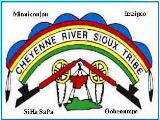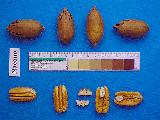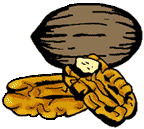|

 Each
spring, Tommy Thompson dresses in a "space suit" and visits 6th- to 8th- grade
classes in his hometown of College Station, Texas. Dr. Thompson does this
because he's a mentor--a teacher who helps young people learn new and
interesting things. Each
spring, Tommy Thompson dresses in a "space suit" and visits 6th- to 8th- grade
classes in his hometown of College Station, Texas. Dr. Thompson does this
because he's a mentor--a teacher who helps young people learn new and
interesting things.
His hobby is beekeeping and he
shares what he knows about bees with young people. The space suit he wears is
actually a special suit to protect him from bee stings. His real work is
breeding pecan trees in the only national pecan tree breeding program in the
world, operated by the U.S. Department
of Agriculture (USDA).
Pecans, produced by the trees,
are a native North American crop. Early  Native Americans, as well as
European settlers, harvested pecans by throwing sticks into the trees, knocking
the nuts to the ground. There, pecans were free for the gathering. Native Americans, as well as
European settlers, harvested pecans by throwing sticks into the trees, knocking
the nuts to the ground. There, pecans were free for the gathering.
Today, pecans are a
multimillion-dollar industry. Rural landowners in the Southwest and Southeast
grow pecan trees in large groves or woodland pastures. In 1999, U.S. pecan
production was about 342 million pounds and worth nearly $448 million. Georgia,
Louisiana, Texas, New Mexico and Arizona are the top five pecan-producing
states.
The pecan industry depends on
new tree varieties being developed by plant breeders like Dr. Thompson, who
works for the USDA's Agricultural Research Service (ARS). These scientists make
improvements in the trees to help them overcome diseases.
|
All ARS pecan varieties
are named after Native American tribes. The most recent tree released is
Nacono. Nacono's parents were pecans named Cheyenne and Sioux, both well
known for their high-quality nuts and resistance to a disease known as scab.
|
 |
|
Image
courtesy of Gregg J. Bourland, Eagles Watch Over Him, Tribal Chairman, Cheyenne
River Sioux Tribe. |
Scab is a fungal disease that
attacks both nuts and leaves. Pecan trees grown east of central Texas are the
most susceptible. To control this unsightly and damaging disease, growers spray
fungicides as often as 10 times a year.
 But Nacono has natural scab resistance so that
growers won't have to spray chemicals as much. That, in turn, will help protect
the environment. A Nacono pecan tree produces a large, high-quality nut. And it
grows well in the eastern United States and in many other pecan-production
areas of the world. But Nacono has natural scab resistance so that
growers won't have to spray chemicals as much. That, in turn, will help protect
the environment. A Nacono pecan tree produces a large, high-quality nut. And it
grows well in the eastern United States and in many other pecan-production
areas of the world.
ARS doesn't give out trees, but
does provide material called graftwood to nurseries. Nursery operators in turn
produce budded trees for sale to homeowners and commercial growers. It usually
takes 2 to 3 years after a new variety is released before nurseries are ready
to sell trees to the public. USDA does include seedlings of new varieties in
the ARS National
Plant Germplasm System (NPGS).
That's so these new varieties can be available for research purposes, including
development of trees that your parents can buy from a nursery near your
hometown.
Here are some interesting
facts about pecans:
- Webster's New World
Dictionary of the American Language defines pecan as a hard-shelled nut of
Algonquian origin. Algonquins were a large family of Native American tribes,
including Arapahoe, Blackfoot,
 Cheyenne, Chippewa, Fox, Ottawa,
Shawnee and many others. Native Americans ate pecans in the fall of the year.
It's not surprising that pecan pie is among favorite holiday foods, along with
pumpkin pie. Cheyenne, Chippewa, Fox, Ottawa,
Shawnee and many others. Native Americans ate pecans in the fall of the year.
It's not surprising that pecan pie is among favorite holiday foods, along with
pumpkin pie.
- On his deathbed, former Texas
Governor James Hogg asked that a pecan tree be planted at the head of his
gravesite, instead of a marble or stone monument. He died on March 2 (Texas
Independence Day), 1906. Pecan is now the state tree of Texas.
- Astronauts took pecans to the
moon in two Apollo space missions. Pecan wood is used in agricultural
implements, baseball bats, hammer handles, furniture, wall paneling, flooring,
religious carvings, and firewood.
For a history of USDA's pecan
breeding program, go to
http://extension-horticulture.tamu.edu/carya/history.htm
Based on the interesting facts that you just learned, what item among
the following would NOT be made from pecan wood?
|
-- By Linda McGraw, formerly, Agricultural
Research Service, Information Staff |
|

 Cheyenne, Chippewa, Fox, Ottawa,
Shawnee and many others. Native Americans ate pecans in the fall of the year.
It's not surprising that pecan pie is among favorite holiday foods, along with
pumpkin pie.
Cheyenne, Chippewa, Fox, Ottawa,
Shawnee and many others. Native Americans ate pecans in the fall of the year.
It's not surprising that pecan pie is among favorite holiday foods, along with
pumpkin pie.